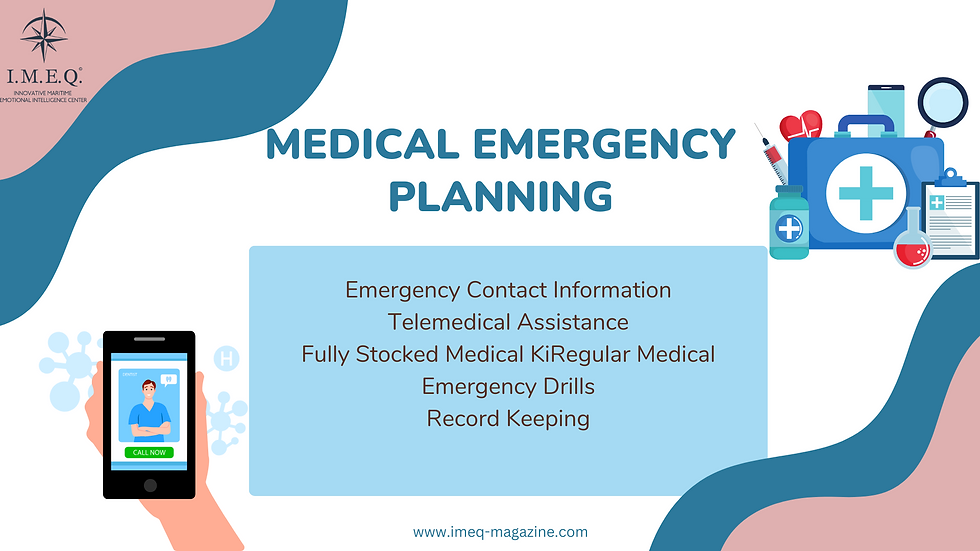Comprehensive Guide to Managing Medical Emergencies Onboard for Seafarers
- IMEQ CENTER

- Oct 16, 2023
- 4 min read
Updated: Oct 19, 2023

Recognizing, Responding to, and Managing Critical Health Situations at Sea
Basic First Aid Knowledge:
CPR (Cardiopulmonary Resuscitation):
Check the Area:Ensure the area is safe for both you and the victim.
1.Assess the Victim:
Check the victim for responsiveness. Shake or shout at the victim.
2.Call for Help:If alone, call for help or send someone to do so.
3.Assess Breathing and Pulse:Check the victim’s breathing and pulse. If absent, begin CPR.
4.Position the Victim:Lay the victim on their back on a firm surface.
5.Perform Chest Compressions:
a. Place the heel of one hand on the center of the victim’s chest. Place the other hand on top, interlocking fingers.
b. Press down hard and fast – compress the chest at least 2 inches deep and at a rate of 100-120 compressions per minute.
6.Give Rescue Breaths:
Open the victim’s airway by tilting their head backward and lifting the chin.
Pinch the nose shut and cover the victim’s mouth with yours, creating an airtight seal.
Give 2 rescue breaths (each should take about 1 second and make the chest visibly rise).
7.Continue CPR:Continue CPR with a cycle of 30 chest compressions and 2 rescue breaths until professional help arrives or the victim shows signs of life.
Wound Care
1.Wash Hands:If possible, wash your hands and wear gloves.
2.Apply Pressure: Apply firm pressure to the wound with a clean cloth or your hands to stop bleeding.
3.Clean the Wound:Rinse the wound with clean, warm water.
4.Apply Dressing:Apply a clean dressing or bandage to the wound.
5.Secure Dressing:Secure the dressing with adhesive tape or bandage.
6.Seek Further Medical Help:If the wound is serious or you’re unable to clean it effectively, seek further medical assistance
Burn Treatment:
1.Cool the Burn:Run cool (not cold) water over the burn or apply a cool, wet cloth.
2.Cover the Burn:Cover the burn with a non-stick, sterile bandage.
3.Provide Pain Relief:Offer over-the-counter pain relievers if available and not contraindicated.
4.Avoid Breaking Blisters:Do not break any blisters that form.
5.Seek Medical Attention:For serious burns, seek immediate medical attention
Advanced Medical Knowledge:
Advanced Life Support:
For using Automated External Defibrillators (AEDs):
1.Turn On the AED:Follow the voice and/or visual prompts.
2.Attach the Pads:Attach the electrode pads to the victim’s bare chest as illustrated on the pads.
3.Clear the Victim:Ensure no one is touching the victim, then press the AED’s “shock” button if instructed
Handling Specific Emergencies:
Broken Bones:
1.Immobilize the injured area using a splint or similar support.
2.Apply cold to reduce swelling.
3.Elevate the injured area.
4.Provide pain relief if available and not contraindicated.
5.Seek further medical help.
Hypothermia:
1.Move the victim to a warmer place.
2.Remove wet clothing.
3.Warm the victim with blankets or other coverings.
4.Give warm, non-alcoholic beverages if the victim is conscious.
Heatstroke:
1.Move the victim to a cooler place.
2.Cool the victim with damp cloths or a cold bath.
3.Offer sips of water if the victim is conscious.
Medication Administration: Know how and when to administer essential medications, such as epinephrine for allergic reactions.
1.Recognize Symptoms of Anaphylaxis:
Symptoms may include:
Difficulty breathing or shortness of breath.
Swelling of the face, lips, or throat.
Rapid or weak pulse.
Skin rash, hives, or itching.
Confusion or altered consciousness.
Nausea, vomiting, or diarrhea.
2.Before Administering Epinephrine:
Confirm the Allergy and Symptoms:Ensure the symptoms match those of anaphylaxis and the patient has a known allergy.
3.Contact Medical Help:If possible, contact medical professionals for assistance and guidance.
Administering Epinephrine with an Auto-Injector (e.g., EpiPen®):
1.Obtain the Auto-Injector:Locate the ship’s medical kit and obtain the epinephrine auto-injector.
2.Check the Expiration Date:Ensure the medication has not expired.
3.Remove Safety Cap:Take off the safety cap from the auto-injector.
4.Position the Injector:Hold the auto-injector in your fist with the tip facing downward.Position it against the outer thigh of the patient, at a right angle to the leg.
5.Administer the Injection:Press the auto-injector firmly against the thigh to release the needle and administer the dose.Hold the auto-injector in place for about 10 seconds to ensure the full dose is delivered.
6.Note the Time of Administration:Keep track of when the medication was administered.
Follow Up Care:
Monitor the patient’s symptoms and vital signs.
Perform CPR if the patient stops breathing or loses pulse.
Contact medical professionals for further instructions.
If symptoms do not improve, or worsen, and a second auto-injector is available, administer a second dose after 5 to 15 minutes

Medical Emergency Planning:
Emergency Contact Information:Ensure access to up-to-date emergency contact information for relevant medical professionals and organizations.
Telemedical Assistance:Many ships have access to telemedical assistance services, which can provide remote guidance for managing medical emergencies.
Medical Supplies:
Fully Stocked Medical Kit:Ensure the ship has a well-stocked and organized medical kit with necessary supplies and medications.
Proper Equipment:Ensure access to essential medical equipment such as AEDs, splints, and bandages.
Continuous Training and Drills:
Regular Medical Emergency Drills:Conduct regular drills to ensure all crew members know their roles in a medical emergency.
Continuous Learning:Encourage continuous learning and staying up-to-date with the latest medical emergency response guidelines.
Communication:
Clear Communication:Ensure clear and effective communication among the crew during a medical emergency.
Language Commonality:Ensure key terms and instructions are understood by all crew members, possibly by using a commonly spoken language.
Documentation:
Record Keeping:
Document all medical treatments and communications for future reference and analysis.
Conclusion:
In conclusion, preparation for medical emergencies at sea involves a combination of training, planning, and proper supply and equipment management. Continuous training and regular drills can help ensure that all crew members know how to respond effectively to a range of medical emergencies, potentially saving lives and preventing further harm.





































































































Comments